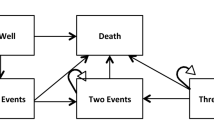Abstract
Canadian guidelines recommend non vitamin K antagonists (NOACs) in preference to vitamin K antagonists (VKAs) for stroke prevention in patients with atrial fibrillation (AF), but NOACs are more expensive than VKAs. Canada has a universal healthcare system that covers the cost of NOACs for select patient groups. Ability to pay for NOACs may influence their use. We reviewed medical charts of Hamilton General Hospital outpatients under the age of 65 with a new diagnosis of AF who were referred for initiation of OAC therapy. We contacted these patients by phone and asked them to complete a questionnaire regarding their OAC choice, economic factors that may have influenced this choice (income, insurance) and the financial burden of OAC therapy. We included 110 patients, mean age 56 years, and 26.4% females. NOAC users had a higher median neighborhood income than VKA users (p = 0.0144, n = 110). 73 patients responded to the questionnaire. NOAC users reported higher annual household income (p = 0.0038, n = 73). Patients with private insurance were more likely to use NOACs than those without insurance (p = 0.0496, n = 73). The cost of NOACs and ability to pay is a determinant of their use Ontario patients under the age of 65. This two tiered provision of care appears to contradict the values of Canada’s universal healthcare system.




Similar content being viewed by others
References
Wolf PA, Abbott RD, Kannel WB (1991) Atrial fibrillation as an independent risk factor for stroke: the Framingham Study. Stroke 22(8):983–988
Hart RG, Pearce LA, Aguilar MI (2007) Meta-analysis: antithrombotic therapy to prevent stroke in patients who have nonvalvular atrial fibrillation. Ann Intern Med 146(12):857–867. https://doi.org/10.7326/0003-4819-146-12-200706190-00007
Ogilvie IM, Newton N, Welner SA, Cowell W, Lip GY (2010) Underuse of oral anticoagulants in atrial fibrillation: a systematic review. Am J Med 123(7):638–645 (e634)
Gladstone DJ, Bui E, Fang J, Laupacis A, Lindsay MP, Tu JV, Silver FL, Kapral MK (2009) Potentially preventable strokes in high-risk patients with atrial fibrillation who are not adequately anticoagulated. Stroke 40(1):235–240
Skanes AC, Healey JS, Cairns JA, Dorian P, Gillis AM, McMurtry MS, Mitchell LB, Verma A, Nattel S (2012) Focused 2012 update of the Canadian Cardiovascular Society atrial fibrillation guidelines: recommendations for stroke prevention and rate/rhythm control. Can J Cardiol 28(2):125–136. https://doi.org/10.1016/j.cjca.2012.01.021
Zheng B, Poulose A, Fulford M, Holbrook A (2012) A pilot study on cost-related medication nonadherence in Ontario. J Popul Ther Clin Pharmacol 19(2):e239
Sholzberg M, Gomes T, Juurlink DN, Yao Z, Mamdani MM, Laupacis A (2016) The influence of socioeconomic status on selection of anticoagulation for atrial fibrillation. PLoS ONE. https://doi.org/10.1371/journal.pone.0149142
Lauffenburger JC, Farley JF, Gehi AK, Rhoney DH, Brookhart MA, Fang G (2015) Factors driving anticoagulant selection in patients with atrial fibrillation in the United States. Am J Cardiol 115(8):1095–1101. https://doi.org/10.1016/j.amjcard.2015.01.539
Drug Benefit List 2016 (2016). http://www.healthycanadians.gc.ca/publications/health-system-systeme-sante/nihb-drug-list-2016-liste-medicaments-ssna/alt/pub-eng.pdf. Accessed 18 Aug 2016
Kennedy J, Morgan S (2009) Cost-related prescription nonadherence in the United States and Canada: a system-level comparison using the 2007 International Health Policy Survey in Seven Countries. Clin Ther 31(1):213–219. https://doi.org/10.1016/j.clinthera.2009.01.006
Kirking DM, Lee JA, Ellis JJ, Briesacher B, Mckercher PL (2006) Patient-reported underuse of prescription medications: a comparison of nine surveys. Med Care Res Rev 63(4):427–446
Piette JD, Heisler M, Krein S, Kerr EA (2005) The role of patient-physician trust in moderating medication nonadherence due to cost pressures. Arch Intern Med 165(15):1749–1755
Krieger N (1992) Overcoming the absence of socioeconomic data in medical records: validation and application of a census-based methodology. Am J Public Health 82(5):703–710
Gomes T, Mamdani MM, Holbrook AM, Paterson JM, Hellings C, Juurlink DN (2013) Rates of hemorrhage during warfarin therapy for atrial fibrillation. CMAJ 185(2):E121–E127
Author information
Authors and Affiliations
Corresponding author
Ethics declarations
Conflict of interest
PK is the recipient of an educational grant from the Haematology Society of Australia and New Zealand. JE is the recipient of a mid-career award from the Heart and Stroke Foundation and holds the Jack Hirsh/Population Health Research Institute Chair in Thrombosis and Atherosclerosis, and has received honoraria from Astra-Zeneca, Bayer, Boehringer-Ingelheim, Bristol-Myer-Squibb, Daiichi-Sankyo, Eli-Lilly, Glaxo Smith-Kline, Janssen and Sanofi-Aventis. JE has received grants and/or in-kind support from Astra-Zeneca, Bayer, Boehringer-Ingelheim, Bristol-Myer-Squibb, Glaxo-Smith-Kline, Pfizer, Janssen and Sanofi Aventis. The rest of the authors declare that they have no conflict of interest.
Ethical approval
All procedures performed in studies involving human participants were in accordance with the ethical standards of the institutional and/or national research committee and with the 1964 Helsinki declaration and its later amendments or comparable ethical standards.
Informed consent
Informed consent was obtained from all individual participants included in the study.
Research involving human and animal participants
This article does not contain any studies with animals performed by any of the authors.
Rights and permissions
About this article
Cite this article
Monagle, S.R., Hirsh, J., Bhagirath, V.C. et al. Impact of cost on use of non-vitamin K antagonists in atrial fibrillation patients in Ontario, Canada. J Thromb Thrombolysis 46, 310–315 (2018). https://doi.org/10.1007/s11239-018-1692-4
Published:
Issue Date:
DOI: https://doi.org/10.1007/s11239-018-1692-4




